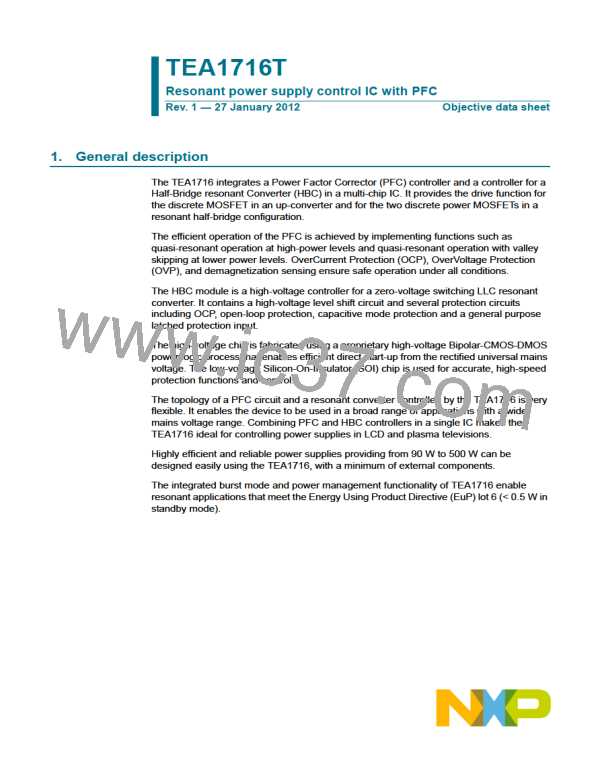TEA1716T
NXP Semiconductors
Resonant power supply control IC with PFC
and Figure 11. Since the half-bridge slope normally starts directly after the MOSFET is
switched off, the length of time the oscillator current is low is negligible under normal
operating conditions.
7.8.6 HBC feedback input (pin SNSFB)
In a typical power supply application, the output voltage is compared and amplified on the
secondary side. The output of the error amplifier is transferred to the primary side via an
optocoupler. This optocoupler can be connected to the SNSFB pin. The current setting of
the optocoupler can be selected using the external pull-up resistor.
The SNSFB pin is a voltage input. At an SNSFB voltage of Vfmin(SNSFB) (6.4 V typical) the
frequency is at a minimum. The maximum frequency is reached at Vfmax(SNSFB)
(4.1 V typical). The maximum frequency that can be reached using pin SNSFB is lower
(60 % typical) than the maximum frequency that can be reached using pin SSHBC/EN.
7.8.7 HBC open-loop protection, OLP-HBC (pin SNSFB)
Under normal operating conditions, the optocoupler current is between Ifmin(SNSFB) and
Ifmax(SNSFB) and pulls down the voltage at pin SNSFB. Due to an error in the feedback
loop, the current could be less than Ifmin(SNSFB) with the HBC controller delivering
maximum output power.
The HBC controller features open-loop protection (OLP-HBC), which monitors the voltage
on pin SNSFB. When VSNSFB exceeds Volp(SNSFB), the protection timer is started. The
Restart state is activated if the OLP condition is still present after the protection time has
elapsed.
7.8.8 HBC soft start (pin SSHBC/EN)
The relationship between switching frequency and output current is not constant. It
depends strongly on the output voltage and the boost voltage. This relationship can be
complex. The TEA1716 contains a soft start function to ensure that the resonant converter
starts or restarts with safe currents. This soft start function forces a start at such a high
frequency that currents are acceptable under all conditions. Soft start then slowly
decreases the frequency. Normally, output voltage regulation has taken over frequency
control before soft start has reached its minimum frequency. Limiting the output current
during start-up also limits the rate at which the output voltage rises and prevents an
overshoot.
Soft start utilizes the voltage on pin SSHBC/EN. external capacitor Css(HBC) sets the timing
of the soft start. Pin SSHBC/EN is also used as an enable input. Soft start voltage levels
are above the enable voltage thresholds.
7.8.8.1 Soft start voltage levels
Figure 13 shows the relationship between the soft start voltage at pin SSHBC/EN and the
voltage across resistor Rfmax, which is directly related to the frequency.
TEA1716T
All information provided in this document is subject to legal disclaimers.
© NXP B.V. 2012. All rights reserved.
Objective data sheet
Rev. 1 — 27 January 2012
25 of 46

 ETC [ ETC ]
ETC [ ETC ]